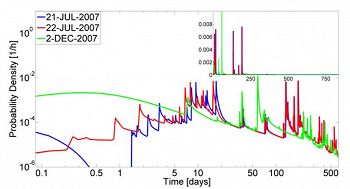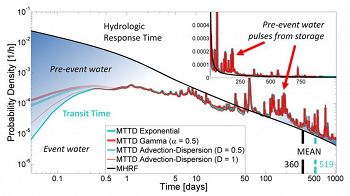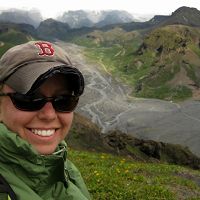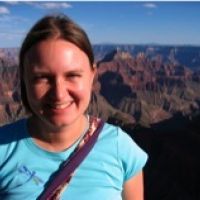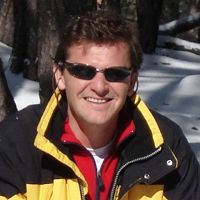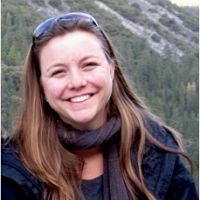Surface Water Dynamics
Streams are natural integrators of landscape, subsurface, and in-stream biogeochemical processes at the catchment- to basin-scale. This subtheme utilizes stream water chemistry in relation to hydrologic response to investigate the importance of energy inputs, water transit times, bedrock mineralogy, landscape age, vegetation, and carbon cycling on critical zone development (e.g. mineral weathering rates).
Image: Jemez River. Photo: Jessica Driscoll
This group is tagged with:
-
Groundwater transit times are greatest in streams draining north-facing hillslopes with lower solar radiation, thicker soils and deeper flowpaths. These longer transit times may enhance mineral weathering rates and increase dissolved solute loads to surface waters. In addition, north-facing catchments may have greater net ecosystem production due to increased water availability. Cooler and wetter soils should reduce heterotrophic soil respiration, increasing both soil carbon pools and dissolved organic matter export relative to south facing catchments.
Transit time modeling
The Surface Water Hydrology Group developed a generalized modeling approach to track the time-variable hydrologic response of catchments and their associated water transit time distributions. The method is based on the realization that there is a distinct difference between the hydrologic response (i.e. unit hydrograph) and the particle response (i.e. water transit time distribution), although both are controlled by processes taking place in catchment storage. A 'particle' is a small parcel of water with an associated clearly defined tracer concentration. The observed streamflow hydrograph after storm rainfall is usually composed of pre-event and event water, and their ratio depends on initial storage conditions and precipitation intensity characteristics. If no water is in storage (a hypothetical case) then any measurable hydrologic response has to be event water and thus equals the water transit time distribution. In any other case, pre-event water will be mobilized together with event water en route to the outlet and the sampled mixture will represent, at any given time, the distribution of ages of the water. Only when the system is in steady state (inflow balances outflow and thus storage does not change) will the catchment exhibit a time-invariant transit time distribution. We therefore need to be able to track not only the time-varying nature of water transit times but also the variations in hydrologic response.
If sufficiently long time series data of precipitation and streamflow and their associated tracer concentrations are available for a given study site, applying our method will generate an ensemble of water transit time distributions (TTD) and associated hydrologic response functions (HRF). Each of these functions has a certain probability of occurrence and their combined distribution function represents a more realistic catchment descriptor to study similarities between catchments or landscape/climate controls on water transit time. We have introduced the concept of the master transit time distribution (MTTD) and associated master hydrologic response function (MHRF) as new catchment descriptors. Convergence of the master functions will have been reached once the addition of further TTDs or HRFs will not significantly alter their shape.Examples of variable transit time distributions for Marshall Gulch, AZ (Heidbuechel et al., 2012).
Master transit time distributions (MTTD) using four different transfer function models and master hydrologic response function (MHRF) for Marshall Gulch. The means of the distributions are indicated by vertical lines. Pre-event water fraction is indicated in blue (between the two functions), event water fraction is left white (area below both functions). Note that the units for the linear axes of the inset are the same as for the larger logarithmic axes (Heidbuechel et al., 2012.
-
Contacts
-
Catalina-Jemez, INVESTIGATOR
-
Catalina-Jemez, INVESTIGATOR
-
Catalina-Jemez, INVESTIGATOR
12 People
INVESTIGATOR
.(JavaScript must be enabled to view this email address)
Hydrology, biogeochemistry, terrestrial and aquatic ecosystems
INVESTIGATOR, Lead-PI
.(JavaScript must be enabled to view this email address)
Univ. of Arizona
Environmental Chemistry and Environmental Biogeochemistry
STAFF, COLLABORATOR
VCNP
Hydrology, Water Chemistry, Biogeochemistry, Geomorphology
GRAD STUDENT
.(JavaScript must be enabled to view this email address)
Hydrology, Geochemistry
GRAD STUDENT
.(JavaScript must be enabled to view this email address)
Univ. of Arizona
Hydrology, Flow and transport in hydrological systems, Geochemistry
INVESTIGATOR
.(JavaScript must be enabled to view this email address)
Univ. of Arizona
Hydrology, Geophysics
STAFF, Field Manager
.(JavaScript must be enabled to view this email address)
Geography, Climatology
INVESTIGATOR
.(JavaScript must be enabled to view this email address)
Hydrology
INVESTIGATOR
.(JavaScript must be enabled to view this email address)
Hydrology and Biogeochemistry
UNDERGRAD
.(JavaScript must be enabled to view this email address)
Univ. of Arizona
Biogeochemistry
INVESTIGATOR
.(JavaScript must be enabled to view this email address)
Univ. of Arizona
Hydrology
GRAD STUDENT
.(JavaScript must be enabled to view this email address)
Hydrology
Alumni-Former
GRAD STUDENT
.(JavaScript must be enabled to view this email address)
Geomorphology
GRAD STUDENT
.(JavaScript must be enabled to view this email address)
Hydrology
-
-
Featured Publications
2012
The master transit time distribution of variable flow systems. Heidbüchel I., Troch P.A., Lyon S.W., and Weiler M. (2012): Water Resources Research 48(6): W06520
2011
Determining Controls on Variable Response Times from Nested Sub-catchments. I. Heidbuechel, Troch, P.A. (2011): AGU Fall Meeting Presentations Abstract H43N-05.
2010
Tracking Varying Mean Transit Time in a Semi-Arid Catchment . Heidbuechel, I., Troch, P.A., Lyon, S.W. (2010): AGU Fall Meeting (Poster) Abstract H11C-0813.
Explore Further

